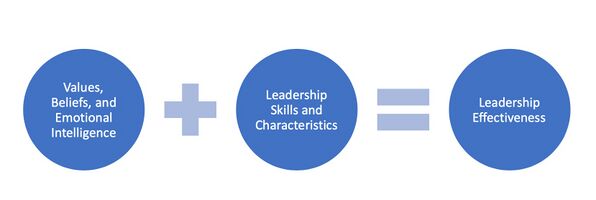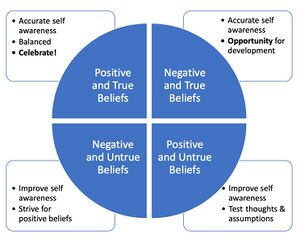Leading in Rehabilitation - Implement the Leadership Approach: Difference between revisions
No edit summary |
No edit summary |
||
| Line 28: | Line 28: | ||
== Leadership Effectiveness == | == Leadership Effectiveness == | ||
Essentially, leaders strive to achieve leadership effectiveness (see Figure 1) | Essentially, leaders strive to achieve leadership effectiveness (see Figure 1), which is defined as:<blockquote>“The successful exercise of personal influence by one or more people that results in accomplishing shared objectives in a way that is personally satisfying to those involved.”<ref>Cooper JF, Nirenberg J. Leadership effectiveness. In Encyclopedia of Leadership. Ed. Thousand Oaks, CA: SAGE, 2004. p845-54.</ref></blockquote> | ||
[[File:Leadership Effectiveness.jpg|thumb|596x596px|Figure 1. Leadership effectiveness.]] | [[File:Leadership Effectiveness.jpg|thumb|596x596px|Figure 1. Leadership effectiveness.]] | ||
The personal influence described in this quote refers to the combined impact of personal values, beliefs, and emotional intelligence. Together, these provide a foundation for the implementation or execution of a leadership approach.<ref name=":0">Giesbrecht J. Implement the Leadership Approach Course. Physioplus. 2022.</ref> | The personal influence described in this quote refers to the combined impact of personal values, beliefs, and emotional intelligence. Together, these provide a foundation for the implementation or execution of a leadership approach.<ref name=":0">Giesbrecht J. Implement the Leadership Approach Course. Physioplus. 2022.</ref> | ||
Values, beliefs, and emotional intelligence provide a basis upon which the leadership approach, or the leadership skills and characteristics associated with each approach, can be implemented.<ref name=":0" /> | Values, beliefs, and emotional intelligence provide a basis upon which the leadership approach, or the leadership skills and characteristics associated with each approach, can be implemented.<ref name=":0" /> | ||
=== Personal Values === | |||
<blockquote>"[P]ersonal values can be defined as trans-situational goals that vary in importance and serve as guiding principles in people’s lives."<ref>Barni D, Danioni F, Benevene P. [https://www.frontiersin.org/articles/10.3389/fpsyg.2019.01645/full Teachers' self-efficacy: the role of personal values and motivations for teaching]. Front Psychol. 2019;10:1645. </ref></blockquote>They are the inner standards from which you receive the motivation to act and by which you make decisions and judge behaviour. They represent a deep expression of what is most important to you.<ref name=":0" /> | |||
=== Beliefs === | |||
[[File:Beliefs in Leadership.jpg|thumb|Figure 2. Beliefs.]] | |||
Beliefs are thoughts, assumptions, outlooks and attitudes that we favour about ourselves and others (Figure 2). They arise from evidence, tradition, authority, association, and revelation.<ref name=":0" /> | |||
Belief domains are summarised in Table 1. | |||
{| class="wikitable" | |||
|+Table 1. Belief Domains.<ref name=":0" /> | |||
!Domains | |||
!Positive Beliefs | |||
!Negative Beliefs | |||
|- | |||
|Self | |||
|“I am worthy of love and happiness” | |||
|“I am flawed and unlovable” | |||
|- | |||
|Others | |||
|“Others like me and value my opinion” | |||
|“People are generally hurtful and disloyal” | |||
|- | |||
|The world | |||
|“The world is my oyster!” | |||
|“The world is a dangerous place” | |||
|- | |||
|The future | |||
|“The future is bright and opportunity awaits” | |||
|“There is no hope – things will never get better” | |||
|} | |||
=== What is Emotional Intelligence? === | |||
<blockquote>"Emotional intelligence (EI) can be defined as the ability to identify, express, understand, manage, and use emotions. EI has been shown to have an important impact on health, relationships, and work/academic performance."<ref>Kotsou I, Mikolajczak M, Heeren A, Grégoire J, Leys C. Improving emotional intelligence: a systematic review of existing work and future challenges. Emotion Review. 2019;11(2):151-65. </ref></blockquote>It enables individuals to:<ref name=":0" /> | |||
* Recognise, understand, and manage the emotions of one's self, and of others | |||
* Express our thoughts | |||
* Develop and maintain social relationships | |||
* Cope with challenges | |||
* Use emotional information in an effective and meaningful way | |||
Emotional quotient is a measure of emotional intelligence.<ref>Gilar-Corbi R, Pozo-Rico T, Sánchez B, Castejón JL. [https://www.ncbi.nlm.nih.gov/pmc/articles/PMC6808549/ Can emotional intelligence be improved? A randomized experimental study of a business-oriented EI training program for senior managers]. PLoS One. 2019 23;14(10):e0224254.</ref> <ref name=":1">Sánchez-Teruel D, Robles-Bello MA, Camacho-Conde JA. [https://journals.plos.org/plosone/article?id=10.1371/journal.pone.0236087 Assessment of emotional intelligence in adults with down syndrome: Psychometric properties of the Emotional Quotient Inventory]. PLoS One. 2020;15(7):e0236087.</ref> It incorporates: self-awareness; self-management; social awareness; and relationship management.<ref name=":1" /> | |||
== References == | == References == | ||
[[Category:Physioplus Content]] | [[Category:Physioplus Content]] | ||
[[Category:Course Pages]] | [[Category:Course Pages]] | ||
Revision as of 23:38, 16 April 2022
Original Editor - Jess Bell based on the course by
Jason Giesbrecht
Top Contributors - Jess Bell and Kim Jackson
Introduction[edit | edit source]
There is often a gap between knowing about leadership and actually doing the leading. Bridging this gap can help people in informal and formal leadership roles become capable and influential leaders in rehabilitation. Leaders must be able to:
- Assess the situation
- Select an appropriate leadership approach
- Implement the leadership approach
- Reflect on and learn from the experience
This page focuses on the third step of implementing the optimal leadership approach. It explores specifically eight prominent leaderphip styles, which are discussed in detail here. These leadership styles are:
- Transformational
- Transactional
- Charismatic
- Servant
- Laissez-faire (delegative)
- Authoritarian (autocratic)
- Participative (democratic)
- Coaching
Leadership Effectiveness[edit | edit source]
Essentially, leaders strive to achieve leadership effectiveness (see Figure 1), which is defined as:
“The successful exercise of personal influence by one or more people that results in accomplishing shared objectives in a way that is personally satisfying to those involved.”[1]
The personal influence described in this quote refers to the combined impact of personal values, beliefs, and emotional intelligence. Together, these provide a foundation for the implementation or execution of a leadership approach.[2]
Values, beliefs, and emotional intelligence provide a basis upon which the leadership approach, or the leadership skills and characteristics associated with each approach, can be implemented.[2]
Personal Values[edit | edit source]
"[P]ersonal values can be defined as trans-situational goals that vary in importance and serve as guiding principles in people’s lives."[3]
They are the inner standards from which you receive the motivation to act and by which you make decisions and judge behaviour. They represent a deep expression of what is most important to you.[2]
Beliefs[edit | edit source]
Beliefs are thoughts, assumptions, outlooks and attitudes that we favour about ourselves and others (Figure 2). They arise from evidence, tradition, authority, association, and revelation.[2]
Belief domains are summarised in Table 1.
| Domains | Positive Beliefs | Negative Beliefs |
|---|---|---|
| Self | “I am worthy of love and happiness” | “I am flawed and unlovable” |
| Others | “Others like me and value my opinion” | “People are generally hurtful and disloyal” |
| The world | “The world is my oyster!” | “The world is a dangerous place” |
| The future | “The future is bright and opportunity awaits” | “There is no hope – things will never get better” |
What is Emotional Intelligence?[edit | edit source]
"Emotional intelligence (EI) can be defined as the ability to identify, express, understand, manage, and use emotions. EI has been shown to have an important impact on health, relationships, and work/academic performance."[4]
It enables individuals to:[2]
- Recognise, understand, and manage the emotions of one's self, and of others
- Express our thoughts
- Develop and maintain social relationships
- Cope with challenges
- Use emotional information in an effective and meaningful way
Emotional quotient is a measure of emotional intelligence.[5] [6] It incorporates: self-awareness; self-management; social awareness; and relationship management.[6]
References[edit | edit source]
- ↑ Cooper JF, Nirenberg J. Leadership effectiveness. In Encyclopedia of Leadership. Ed. Thousand Oaks, CA: SAGE, 2004. p845-54.
- ↑ 2.0 2.1 2.2 2.3 2.4 2.5 Giesbrecht J. Implement the Leadership Approach Course. Physioplus. 2022.
- ↑ Barni D, Danioni F, Benevene P. Teachers' self-efficacy: the role of personal values and motivations for teaching. Front Psychol. 2019;10:1645.
- ↑ Kotsou I, Mikolajczak M, Heeren A, Grégoire J, Leys C. Improving emotional intelligence: a systematic review of existing work and future challenges. Emotion Review. 2019;11(2):151-65.
- ↑ Gilar-Corbi R, Pozo-Rico T, Sánchez B, Castejón JL. Can emotional intelligence be improved? A randomized experimental study of a business-oriented EI training program for senior managers. PLoS One. 2019 23;14(10):e0224254.
- ↑ 6.0 6.1 Sánchez-Teruel D, Robles-Bello MA, Camacho-Conde JA. Assessment of emotional intelligence in adults with down syndrome: Psychometric properties of the Emotional Quotient Inventory. PLoS One. 2020;15(7):e0236087.








